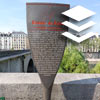One of the series of signs describing historical places in Paris. The signs were placed starting in 1992 and are also called sucettes Starck (Starck’s Lollipops) after Philippe Starck who designed them.
The plaque describes the early days of the Collège de France, a higher research institution, which, unlike the Sorbonne, does not award academic degrees. The institution was originally established to specialize in mathematics, ancient Greek and Hebrew. Today it is engaged in other fields.
The college was photographed on the same day
 Click for a larger image
Click for a larger image  Click for a larger image
Click for a larger image The illustration in the center of the sign is shown here at magnification
 Click for a larger image Translation of the text on the sign
Click for a larger image Translation of the text on the sign:
[An illustration of a ship, symbolizing the symbol of Paris]
History of Paris The College of France In 1530, François I, advised by Guillaume Budé and his humanist entourage, appointed six royal readers (two for Greek, three for Hebrew, one for mathematics) independent of the University. “Basti in men, not in stones”, the “Collegium regium Galliarum” (The Royal College of Gaul) saw its construction further slowed down by the assassination of Henry V: aged 9, Louis XIII laid the first stone of a building in 1610, taken over by Chalgrin in 1773. At the end of the old regime, it had around twenty chairs, where all the innovative teachings found a place, to the point of giving it a model for the reorganization of education planned under the Revolution. Enlarged in the 19th century, it expanded again in the 20th century to cope with the development of its laboratories.
[illustration of the College]

 Click for a larger image
Click for a larger image  Click for a larger image
Click for a larger image  Click for a larger image
Click for a larger image  Click for all signs belonging to The History of Paris (Starck's Lollipops)
Click for all signs belonging to The History of Paris (Starck's Lollipops)
 152 Meter |
152 Meter |  273 Meter |
273 Meter |  280 Meter |
280 Meter |  296 Meter |
296 Meter |  316 Meter
316 Meter